OBSERVING THE PLANETS - Part 3
Last updated: 12 March 2001
OBSERVING THE PLANETS - Part 3 |
"Our Love Affair With the God of War"
Anytime there is an approaching "apparition," or close approach of, of the fiery red planet Mars there is a buzz that increases loudly as the planet moves ever-so-closer to the Earth. Indeed, only every 17 years does Mars offer a fantastically favorable apparition, with recent notable ones in 1956, 1971 and 1988-89. When first making its debut in the early morning skies when still quite distant from the Earth, Mars' distinct reddish color is clearly perceptible to the naked eye, yet telescopically it is a BIG disappointment for those first viewing the mysterious world.
We have all heard about such exciting features as "polar caps," the dark maria, "canals," enormous volcanoes and dust storms planet-wide; yet, when far away Mars presents such a small DISK (we measure the disks of planets in SECONDS (") OF ARC, with Jupiter measuring 44", for example) that much of nothing can be seen nor photographed except in the world's largest telescopes.
Indeed, even when Mars is closest to Earth during PERHELIC OPPOSITIONS, the planet is barely one-half the size of Jupiter as seen through a telescope. So perfect seeing conditions, a good telescope, and a very trained eye (and educated observer!) are critical for spotting the elusive yet exciting features the planet has to offer.
Even on the very best nights never expect to see visually what such striking photography from the Hubble Space Telescope (HST) and other ground-based telescopes are revealing, as shown in Figure 1. On the other hand, astronomer Donald Parker and others using moderate-sized ground-based telescopes have obtained fantastic CCD images that exceed what the largest telescopes on Earth were able to perceive on 15 years ago!
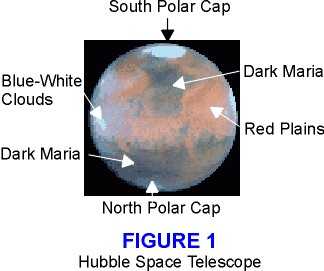
----------------------------------
A BRIEF HISTORY OF OUR "LOVE AFFAIR" WITH MARS -
Fictional stories of Martian lore have led to mass suicides and even stock market crashes throughout modern times.... the fires of ancient wars were kindled by the appearance of the bloody red planet in the eastern skies, and hence the red planet has since become known as the "God of War." Its deep scarlet color to the naked eye exemplifying the spilled blood of warriors in battle.
Mars is so close to Earth (varies from 35 million to over 63 million miles) that its motion is the fastest among the "superior planets," those beyond the orbit of Earth; only Mercury and Venus - closer to the sun - appear to move faster through the sky. As Mars moves eastward throughout each of its apparitions, it passes through many of the "houses" of the ZODIAC, the "band of animals" comprised of the 12 constellations of astrological fame. In history, the movement of Mars from one "house" into another (say from "Taurus" into "Cancer" meant many times calamity or even and EXCUSE to go into battle against an otherwise docile neighbor!
It may seem odd but MARS is the only planet (outside of Earth) that we can actually "view the surface" with our telescopes from Earth, other than Mercury which lends little if no detail. Even Galileo, with his primitive telescope by today's standards, discerned a clear "disk" for Mars but it was a century later that Cassini was able to begin noting dark "maria" regions and the clear, white polar caps on the planet.
Later in history arose the long-held controversy concerning "canals" on Mars, once thought to be artificially-constructed waterways that provided life-giving water for irrigation an thirst from the melting polar caps to the drying populations huddled within the little warmth of the equatorial region of the planet. Part of the "canal" misconception was started quite innocently by the Italian astronomer Schiaparelli who - in 1877 - published detailed drawings he had made with his large refractor in Milan. On that drawing appeared numerous criss-crossing lines which Schiaparelli entitled "canali", or Italian for "channel," merely as a description of their appearance.
By the first decade of the 20th century, "Mars Fever" was rampant" and Percival Lowell (of Lowell Observatory in Flagstaff fame) had cataloged over 400 CANALS, leading fiction writers worldwide to imagine and express to the curious Earth public the existence of what HAD to be a very populous Mars habitation by canal-building fanatics.
Figure 2 demonstrates the remarkable visual appearance as recorded by Lowell of Mars on January 16, 1903 to demonstrate the many linear features ("canals") that were purportedly seen. From my library, this figure is taken from a rare colorized drawing by Lowell to demonstrate the remarkable color variations that he was convinced were due to vegetation that was growing along the canal network.
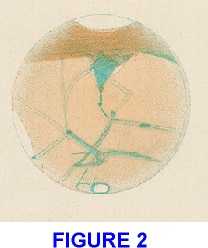
But now we have been to Mars, and there are no "canals"...indeed, no Martians. But one thing is clear about some of these misconceptions: Mars apparently DID have an abundance of water at one time, and there are, indeed, dried channels, river beds and massive canyons of erosion from that water throughout the surface of the mysterious red world.
-----------------------------------
HOW TO KEEP UP WITH MARS
Mars presents its best views every 13 years roughly and those usually occur in August, even though the planet is low in the southern sky for North American viewers; ETX and LX users in low latitudes and near the equator, however are particularly favored. The last such favorable apparitions were in 1986 and 1988 when Mars was in Sagittarius and Pisces, respectively and presented a disk of 23" arc (half the size of Jupiter).
Other, less favorable oppositions of Mars can occur in the months of January and February ("aphelic oppositions") which do not position Mars nearly as close to Earth; however, the planet is much higher in the sky for northern observers during such events.
Because of its highly elliptical (elongated flattened circle) orbit and its 780-day "year" around the sun, Mars only presents itself to Earth viewers every 2 YEARS roughly, unlike Jupiter and Saturn which are visible each year.
In respect to its "day" and "year", Mars is very much like the Earth (only about half the size). It is tilted on its axis like the Earth, at a 23.5 degree angle so it undergoes extreme seasons; it rotates about its axis in about 23 h 37m 23s, thereby presenting different "faces" for view throughout a long night's observing session.
To find out what "face", or CENTRAL MERIDIAN is centered on Mars at any given time, you may consult the "Mars Ephemerides" from the Association of Lunar and Planetary Observers (ALPO); this way you can - based on the longitude you see - correlate markings seen in YOUR telescope under high power to those on a good Martian map. Complete ephemeride information may be downloaded (giving size, magnitude, tilt, Central Meridian (CM) and more from : www.lpl.arizona.edu/~rhill/alpo/marstuff/ephems/marsephem.html .
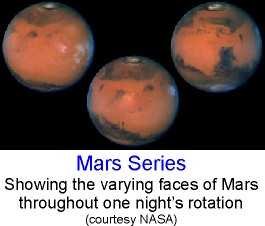
Shown in this three-part striking color montage from the Jet Propulsion Laboratory are the different faces of Mars as it rotates on its axis throughout the duration of one night. Note that SOUTH is up in this photograph.
----------------------------------
WHAT YOU NEED TO KNOW ABOUT OBSERVING MARS -
Nearly weekly I receive inquiries regarding how difficult it is to see detail on JUPITER....."you ain't seen nothin' yet, baby," as the song goes.
Mars is TOUGH! Knowing this ahead of time makes it easier on you to accept what you see, and not to expect to much from all the "Mars hype" that accompanies every apparition. Follow the guidelines listed briefly below to get the most out of your telescope when viewing the Red Planet. For full observing details if you are really serious about getting to know the facts and how YOU can contribute to the body of knowledge of this mysterious world, log on to receive a "Mars Observing Guide" from the ALPO by contacting: www.lpl.arizona.edu/~rhill/alpo/mars.html to get in direct contact with the Mars Section of the ALPO and learn about all the FREE downloads, data, and booklets that are available. Alerts on new events on Mars are also regularly posted on that site.
1) Mars is SMALL. Figure 3, following, demonstrates the relative sizes of Mars with Jupiter and Saturn as they might appear in your ETX or LX 90 telescope at about 230x. Note how tiny the actual globe of Mars is when compared to Jupiter and then to the actual ball of the planet Saturn.
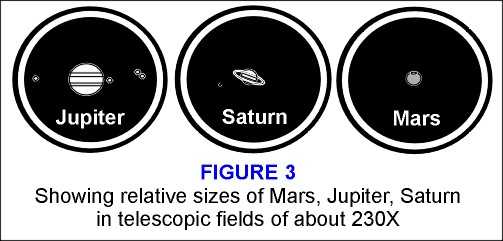
Therefore, knowing that ahead of time you realize that: A) you MUST use as high a magnification as your telescope will allow; and, B) that magnification is going to be LIMITED by the "steadiness" of the night. As much as 100x per inch is not unheard of on Mars.
Check an out-of-focus star image (chose a star near the planet) to see if it oscillates or moves; if so, then you are not going to be able to optimize your power for good viewing....perhaps another night, or simply wait a while and see if it steadies down (around midnight to 3 a.m. is usually your steadiness times of the night).
2) You MUST know what you are looking for! Some detail is conspicuous, such as the bright south polar cap and the dark "Syrtis Major," but most is VERY subtle (See Figure 4). Figure 4 shows an excellent drawing of Mars by E. Antoniadi in 1909 which shows many features as they actually will appear on a very steady night in most large telescopes; most of the larger and darker detail is visible in smaller telescopes.

This is where a good Mars map comes in handy, and there are excellent sources on the ALPO web page. Figure 5 is a quick reference, a Mars projection map that I compiled at the Arkansas Sky Observatory from 1971 through 1982 from hundreds of drawings; this shows the latitude and longitude scale and the many features that CAN be seen in your telescopes. Remember: you must FIRST determine the "Central Meridian" from the ALPO ephemeride download for the exact time at which you observe. Once done, the LONGITUDE is merely matched with that on Figure 5 to show the relationship of each feature. The more detailed maps featured by the ALPO will provide the names of the specific features at any given latitude and longitude.
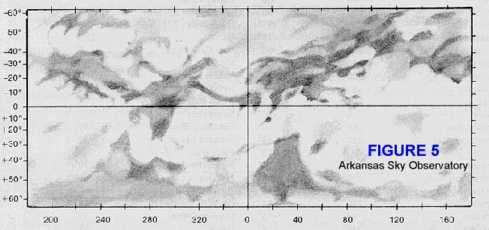
Note that in Figure 5, SOUTH IS UP as is conventional for astronomical charts; the view in a catadioptic such as the ETX and LX scopes present NORTH UP and the image is reversed such as in a mirror.
3) Do not observe in "white light" or light that is unfiltered. I always recommend two (2) filters for Mars: a Wratten #21 Orange for details of the darker "maria" against the ruddy red planet; and a Wratten #80A light blue to look for bright clouds and extensions of the polar areas. Mars frequently has global-wide dust storms (one can be seen developing in my April 14, 1982 drawing - Figure 7c).
4) Use "averted vision," which means you do not stare directly at the image, but rather off to one side slightly; this allows the more sensitive region of the eye to receive the light and the more subtle detail.
5) Only observe Mars when it is a MINIMUM of 25 degrees from the closest horizon, and then even higher altitude is preferred for a more steady and stable view.
----------------------------------
WHAT TO LOOK FOR -
Once you have grown accustomed to the fine detail that Mars CAN offer, you should familiarize yourself with what these features are, how they can change from night to night and the correct nomenclature surrounding each.
POLAR CAPS - Like Earth, Mars presents two polar caps, but unlike Earth its caps are "seasonal," in that they diminish and even disappear in some years when Mars approaches its summer. It is interesting to note the shrinking of the cap each night, and correlate the size to the darkening of some of the other Martian surface features. Indeed, the caps are largely frozen water ice and melting or "sublimation" of the ices do allow some moisture-induced darkening of the maria and otherwise unseen detail.
The NORTH polar cap shrinks each Martian summer to an average of about 6 degrees across and grows to an enormous 72 degrees when Mars recedes from the sun.
The SOUTH polar cap undergoes more changes than its northern counterpart, and it is usually tilted toward us for an excellent view. Defrosting of the cap during Martian summer allows the "Mountains of Mitchell" - dark elevated structures, to emerge from atop the frozen surface. Figure 6, from the Mars Pathfinder mission, demonstrates a slowly-thawing south cap with surface features known as "rifts" to be exposed above the ice layer.
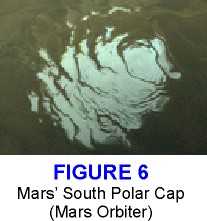
WHITE AND BLUE CLOUDS - These are attributed to near-surface fogs and mists. Frost deposits can also give rise to these tenuous clouds. You should always be on the lookout of these clouds, as they can be watched meteorologically as they move across the surface. The white and blue clouds are best observed with a Wratten #58 green filter as well as #12 yellow (for white clouds). To identify the clouds requires that you KNOW the normal appearance of the surface however!
YELLOW DUST CLOUDS / DUST STORMS - Yellow clouds pop up unexpectedly and are the precursors of the huge yellow dust storms that can literally cover the entire planet in the matter of a few days. Most originate from the Noachis-Hellas basin (latitude -28 degrees, longitude 320 degrees). To watch these clouds develop and circulate, always use the Wratten #21 orange filter or the #12 yellow.
THE BLUE CLEARING - This is a largely-still-not-understood phenomenon whereby you cannot see much detail AT ALL in normal light (regular eyesight) but can utilize a Wratten #47 violet or similar filter and suddenly see enormous amounts of very fine surface detail as though you had "x-ray vision." Search first for such clearings if the planet seems uniformly uninteresting and void of detail with a blue filter and then move to the #47 for best results.
MARIA - These are the many, and multi-shaped dark patches strewn throughout the planet. Their sizes and shapes change. The perimeters and outlines of these features change remarkably throughout each approach and recession of the planet.
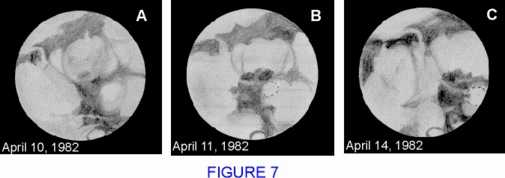
Look carefully at my three drawings of Mars done with the 24-inch telescope on April 11, 12 and 14, 1982. All show nearly the same "face, with the central meridian showing Longitude 350 to around 35 degrees, so virtually the same face over a four-day span of time. Notice how quickly the surface features have changed night-to night. Some of this are due to variations in seeing conditions, but a lot is also due to the rapid changes in color, darkness and size of the Martian Maria, those features that you see as "dark" in these three drawings. Note in Figure 7-c the dotted line that indicates one of those white or yellow clouds forming in the Nix Tanaica region of the northern Martian hemisphere. That cloud continued to grow and then move slowly across the Martian plains for about three consecutive weeks!
SEASONAL CHANGES - A phenomenon known as the "wave of darkening" occurs as the seasons change on the planet; as Mars approaches the sun every 780 days, the warming allows more moisture to leave the frozen ground and become airborne. It is believed that much of the arid surface is so porous that the moisture is quickly absorbed into rock and other materials, thereby darkening it just as rain does when it saturates a stone here on Earth. An interesting project is to use "color swatches" from your local paint store to gauge the relative color changes of the maria (a sort-of brownish-green), the plains (ruddy red/orange) and the bright areas (clouds and polar caps) over a long period of time.
Following is a list of major Martian areas (mostly Maria) that are prone for significant seasonal changes that can be easily monitored in your ETx or LX telescopes (Martian Latitudes & Longitudes given to reference to Mars maps):
Mararitfiger Sinus Latitude -02 degrees / Longitude 30 degrees
Hydrae Sinus -02 / 30
Mare Australe -65 / 40
Acidalius fons +58 / 60
Lunae Lacus +25 / 60
Solis Lacus -35 / 85
Tharsis +10 / 90
Aonius Sinus -45 / 105
Amenthes +05 / 250
Thoana Lalus +35 / 256
Thoth +30 / 256
Nepenthes +20 / 260
Moeris Lacus +08 / 270
Antigones Fons +22 / 290
Syrtis Major +10 / 298
Aeria +10 / 310
-----------------------------------
THE SATELLITES OF MARS
It was first Johannes Kepler, after learning that Galileo had found four (4) moons encircling Jupiter, and knowing that the Earth had ONE, speculated arbitrarily that Mars "....must have TWO." Well, he was right, but totally seredipitously and without basis to his merit. Even Jonathan Swift, in "Gulliver's Travels" hinted that Mars had "...two satellites....the innermost is distant from the [center of Mars] exactly three diameters (of the planet)...and the outermost five.." AND HE WAS RIGHT! How, we do not know.
It was not until 150 years later, in 1870 that U.S. Naval Observatory Director Asaph Hall actually discovered the two: DEIMOS AND PHOBOS ("panic" and "fear", rightfully so with the God of War!). Phobos is only about 20 miles across and Deimos only about 12. It is thought that these "satellites" actually are not natural at all, but rather "shot out" from Mars via a huge volcanic eruption millions of years ago and put into an orbital trajectory that will eventually have them plummeting back down to the surface.
Do NOT expect to see either of these elusive tiny satellites with your telescope, nor the one at your nearest neighborhood observatory!
----------------------------------
KEEPING A RECORD
My philosophy has always been.....if it's worth doing, then it's worth TELLING somebody that you DID it! Hence, the ALPO encourages observers with all types and sizes of telescopes to participate in increasing our knowledge of the Red Planet by submitting observations. YOU can make a difference!
Drawing Mars is perhaps the best way of recording it; only if you have very expensive equipment and years of experience are your chances of good photographic records reasonable. The human eye is still capable of seeing in fleeting glimpses much more detail than any telescope/camera/CCD combination on Earth can record. A good #2 pencil, a flashlight, a chart and your ETX or LX scope is all that is needed.
Be sure to record the DATE and the TIME (Universal Time if possible) of the BEGINNING and the END of each drawing so that the Central Meridian can be determined as described previously.
To obtain good drawing charts (download and then print on some very good paper suitable for drawing), merely log onto www.lpl.arizona.edu/~rhill/alpo/marstuff/marsfrm2.jpg for a transfer. Store in your computer and merely print out each time you need one.
If you are satisfied with the drawing or - IF you find a new cloud or something that really looks like it might not have been there the night before - contact the ALPO via the Internet and describe your finding! You might have been the first to see an emerging dust storm!
---------------------------------
STAYING CURRENT ON MARS -
An excellent way to keep abreast of major discoveries, new photographs from space and announcements concerning Mars is to periodically log onto www.nineplanets.org/mars.html for updates. Fantastic Mars photographs from both land-based and satellite imagery are available and it is a wonderful encyclopedia of information regarding what YOU need to know to pique your excitement with the mysterious Red Planet. ---------------------------------
MARS: A RETROSPECTIVE COMMENT -
Something to keep in mind when you are exploring Mars for the first time, or even if you are a veteran observer......
When we look today at the wonderful images such as those referenced above, we only see Mars as it is TODAY. But consider this: if biological forces of "life" suddenly stopped on Earth...if all productive artificial building was halted and only the NATURAL PROCESSES of wind and water erosion, volcanic activity, earthquakes, etc. were the ONLY forces shaping our world....what would EARTH look like in, say, a hundred million years? How deep beneath our surface would explorers from another planet have to dig to find ANY evidence that life did, indeed, once thrive on this planet?
We cannot go back in time and measure the atmosphere when the rains were plentiful on Mars, but we know they were; nor can we study the chemistry of its air when the huge volcanoes actively added to the density and nature of the very air around the planet. But we DO KNOW that Mars today presents an entirely different face to us than it would have millions of years ago. Today it is a barren, wind-blown and scarred world.
Had the waters lasted long enough, would it have been a world of swimming creatures? At one time were the many and vast craters filled by the tiny tributaries we see today with water, forming huge Martian lakes? And...what might have been within those lakes, and along the edges of those maria.
It is a world once thriving with activity....now gone.
Mars continues, as it has since its polar caps were first discovered in 1659, to be the most mysterious of all the planetary worlds, and it may indeed hold the "Rosetta Stone" to the prehistoric past of our own Earth.
YOUR discovery of this new world is only limited by your willingness to learn and persevere and the unlimited perception of your astronomical imagination.
There ARE no Martians....there ARE no canals....there MAY NOT be any sign of life on Mars as we know it...
....but, like the fire that kindled the fury of wars in ancient times....there STILL is MARS.
P. Clay Sherrod
Arkansas Sky Observatory
Conway / Petit Jean Mountain
Arkansas
Return to the top of this page.
Go back to the Observational Guides & References page.
Go back to my ETX Home Page.